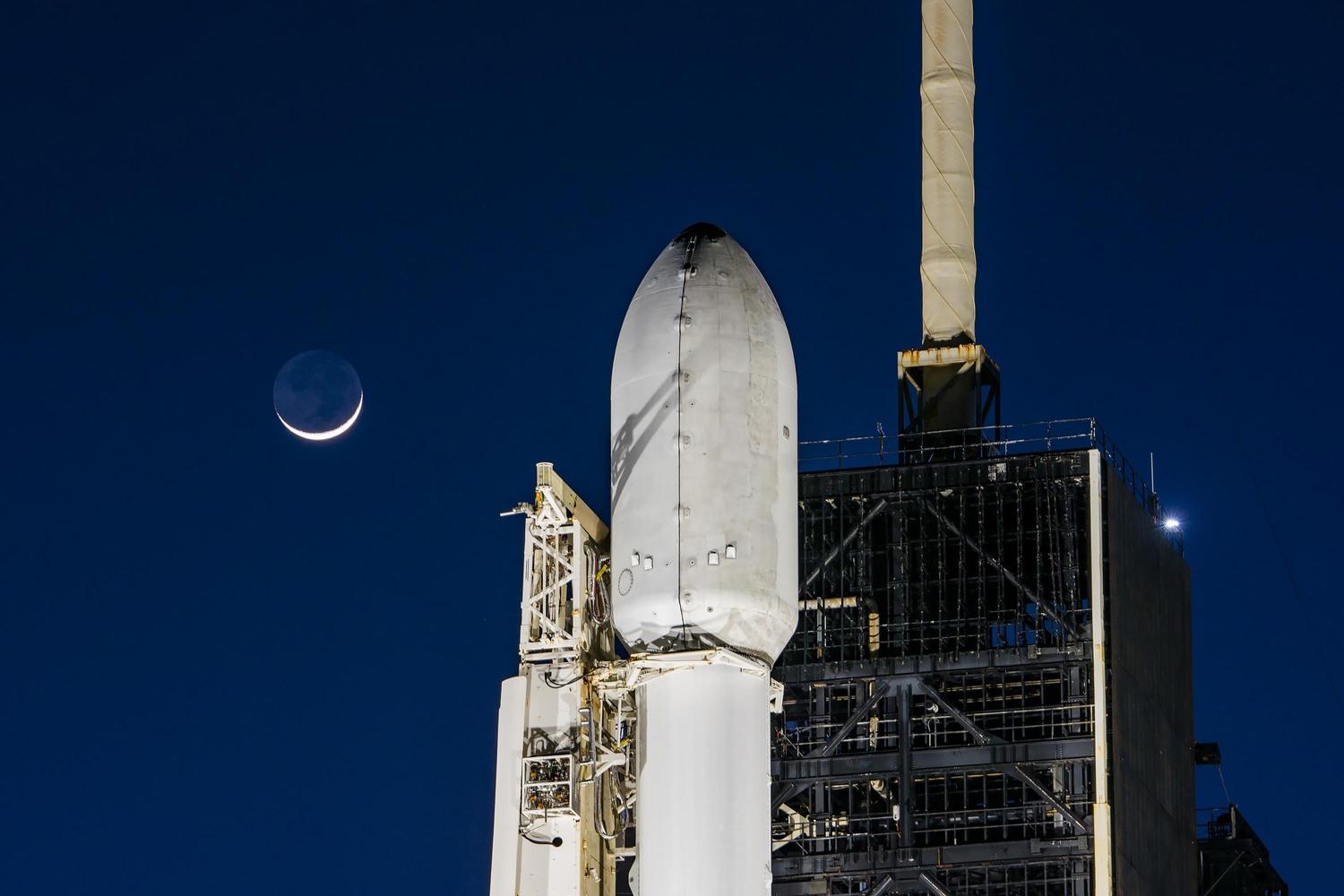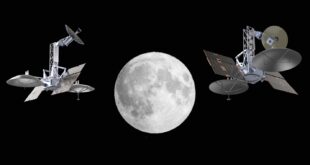by Christophe Bosquillon

The 2024 State of the Union Address was given by the 46th President of the United States, Joe Biden, on March 7, 2024, at 9:00 p.m. EST, in the chamber of the House of Representatives to the 118th Congress. It took place only two weeks after the “successful” landing of NASA CLPS Intuitive Machine M1 Odysseus on the Moon, and as anticipated during a re-election campaign, many were curious about how the President would capitalize on recent US geopolitical and economic forays in space. Why not even expect the presence of NASA Administrator Bill Nelson, astronauts, and space CEOs, among the honoured invitees? But while the SOTU address did cover essential domestic political ground, there was not one word about space! But how is that even possible?! Artemis, the Moon, Mars, American leadership on Earth and in the Solar System, the impact of space affairs on the world, does it matter so little that it should have no place in a presidential SOTU address? Let’s find out.
US space leadership at risk of faltering?
Bethany Ehlmann, a professor of planetary science, director of the Keck Institute for Space Studies at Caltech, and president of the board of the Planetary Society, expresses such concerns best in this opinion piece “It’s an exciting time in space exploration. But U.S. leadership is at risk”. Ehlmann concludes the piece with this: “Our pathways forward are crafted. In 2022, the National Academies completed a new Decadal Survey for planetary science and astrobiology, providing an ambitious, balanced, and executable 10-year plan for completing missions to Europa, Titan, the Moon and Venus, as well as new missions: Mars Sample Return, a Uranus orbiter and mission competitions for any solar system destination. I was privileged to serve with the 100-plus planetary scientists and engineers who took input from thousands of our colleagues to craft that 10-year plan for continued U.S. leadership in space science. But now I see that leadership at risk of faltering.”
The state of the Union Space program
The US Department of Defense is shifting focus (as mentioned in the SWGL review of 2023-2024 investment trends by Space Capital) towards commercial partnerships in space technology, with an annual budget of a trillion dollars. This is having a significant impact on space start-ups and investments. 2023 was the year when defence-related space expenditures in the US surpassed civil space budgets for the first time, indicating a significant shift in government space programs, to last in 2024 and beyond.
Government should also know when and how to get out of the way.
SpaceX dominates civilian launch with Falcon 9 and Falcon Heavy rockets. The latest and third test of Starship is rather promising. Meanwhile, Blue Origin, Orbit Fab, and others are set to compete with SpaceX. Because military launches include contracts with SpaceX and the development of rocket cargo systems on top of NASA contracts, economies of scale for space are becoming possible.
So far the US still leads the world in space program budget ($73 billion), followed by China, Japan, France, Russia, and India. In the policy and strategy area, the US State Department issued the Strategic Framework for Space Diplomacy, emphasizing US leadership and partnerships. Namrata Goswami, in a compelling March 4, 2024 piece “Taking stock of the US space program” comprehensively reviews policy documents from LEO and cislunar strategy, to doctrine and the military realm. But the piece also elaborates and concludes on the fact that, while the US leads in space spending, it faces challenges in translating policies into concrete capabilities and lacks a clear national strategy. This requires reforms and adaptations for the US to maintain its leadership in the evolving space domain.
NASA cuts and internal strategies
While the March 7, 2024 SOTU address took place in the middle of a Congress budgetary stalemate, a protracted process that resulted in NASA’s budget getting cut, space politics being publicly ignored is merely a symptom of an even more concerning root cause.
There have been wasted opportunities, or so many delays they run the risk of not delivering in due time. Such is the case of nuclear propulsion and of Space-based Solar Power (SBSP), SBSP having suffered from deliberately inhibiting assessments. These lost opportunities take away realistic industrial and commercial objectives, that could have helped the US space program focus on building infrastructures, and scaling up, leading to sustainable transportation and energy-economic models.
The process leading to the latest NASA budget cut managed to not completely kill the Mars Sample Return mission, but resulted in unrealistic prospects to make it on time for the 2031 return window. Short term, hundreds of employees and contractors were fired, as assessed in above mentioned Bethany Ehlmann’s piece. The long-term dedication of NASA vis-à-vis China’s competitive approach toward the Moon, Mars, and the Solar System, is in doubt. And the fact that the latest NASA budget cuts managed to “save Artemis” doesn’t change the fact that Artemis is being repeatedly delayed.
The Apollo syndrome
Malcolm Davis, Senior Analyst at the Australian Strategic Policy Institute, commented on the State of the Union address as follows: “NASA has just taken another funding cut – and Artemis keeps being pushed back – even as China works steadily to get its people to the Moon ‘by 2030’. There are areas where the US is making progress, and areas where it’s just crawling. Without top-level political support, the traditional government run space activities will continue to crawl forward.” In another post, Rick Tumlinson suggests that NASA needs to restructure Artemis completely, while speeding up the process that leads to the Moon and beyond it to Mars, and proposes a solution that “NASA starts the job and the American people take over. Otherwise. we get Apollo Mark two.”
To which Malcolm Davis replies that it is “an ‘Apollo Redux’ scenario that worries me the most with the current planning for Artemis – we go, perhaps one or two missions by 2029 – and then the budget is cut and further missions are cancelled – and no long-term US and allied presence on the lunar surface. And Mars recedes off decades into the future.” We do share these concerns, as Artemis delays impact all international partners as well. While in the meantime, we may expect the Chinese (and partners) Space program to proceed eagerly, with the International Lunar Research Station, their own Mars sample return mission, and ambitions beyond Mars. As for India, it is on its way, is unstoppable, and may eventually become a senior partner in Solar System exploration.
Astropolitik
The remaining three-quarters of the 21st century will witness a de facto competition across the Solar System for space domain economic and “astropolitik” development. The space forces of all major space powers are already involved. Considering the ongoing acceleration of efforts in space and Moon diplomacy, we’d like to keep working on the baseline scenario that a proper modus operandi with China and its partners might still be achievable, when it comes to space resource economic utilization, and, implicitly, the ongoing and inevitable militarization of the space domain. In the ILRS, on Mars, and on planetary bodies beyond, a COPUOS-led coordination mechanism might still be part of the economic diplomacy solution, as highlighted in the piece “China and the Moon” by Dr. Fabio Tronchetti.
Space politics being publicly ignored is merely a symptom of an even more concerning root cause.
Part of the problem with any international agreement of that nature is that it is highly dependent on the level of strategic trust between the parties, or lack thereof. In the current geopolitical context, the level of strategic mistrust between the US and China (together with Russia and partners), is likely to get worse before it gets better. This will also impact these countries who try to maintain relationships with both sides, such as the expanded BRICS participating countries and loosely defined “Global South.”
US congressional stalemate and fiscal unsustainability
However, don’t blame China for the US congressional stalemate. The root causes of the problem are inherently linked to a fiscal situation that has become unsustainable. A simple metric, the spending on interest on the US debt, will surpass federal outlays on major budget categories over the next few years: in fiscal year 2024 already, the federal government will spend more on interest than on defence. The President’s Pentagon budget reveals the armed forces are in “a state of managed decline”: “The U.S. needs to diversify and harden its satellites in space, yet the Biden budget would cut the Space Force by $600 million over last year’s request”.
A US Department of Space
Taking stock of budgetary sustainability issues, one may wonder whether the bloated government agencies model remains relevant, after you factor in the weight of the military in the US and among Indo-Pacific space powers. In a piece titled “Bridging the cultural divide for Moon to Mars” Scott Hubbard posits that NASA’s culture is inherently built on 3 pillars that are: science, engineering, and human spaceflight. At the other end of the spectrum, Mike Griffin has argued that the US space ambitions make NASA a national security organisation and Griffin is definitely not alone in thinking along such lines.
Commercially profitable and economically sustainable space domain development should be tackled by public-private partnerships that are fit-for-purpose. That would include cooperation with space agencies and defence, but streamline the policy budgeting and execution. In “Taking stock of the US space program” Namrata Goswami argues that the US needs to adapt its space institutions to current demands, possibly considering the establishment of a dedicated Department of Space for more effective coordination, as well as strategic and budgetary direction.
Space Of The People, By the People, For the People
Space activities in China and India elicit a strong interest across all generations: it is a natural mix of national prestige, patriotic fervour, deep pride in one’s scientists and engineers’ achievements, excitement and endless thirst for knowledge among kids and adults alike, and the natural human drive for exploration, discovery, and the next frontiers. We see a similar interest in many an “Emerging Space Country.” Europe and its youth are vibrantly tackling space domain opportunities. As American society keeps evolving and innovating, there is no reason why the US should fall behind in the space race. Government should jumpstart the trend, and act as an anchor customer, starting with defence. But Government should also know when and how to get out of the way.
Let The People go do what they do best, all across the Solar System.
Disclaimer: the views expressed by Malcolm Davis are provided in personal capacity, and are not meant to represent nor reflect the views and policies of the Australian Strategic Policy Institute (ASPI).

Christophe Bosquillon has a diverse professional background, having operated globally with a focus on the Indo-Pacific region. His experiences in Japan, the Koreas, Taiwan, China, ASEAN, India, Russia, and Australia have given him a deep understanding of the multipolar realpolitik of our world under the Pax Americana. With a background in engineering, trade, and foreign direct investment in industries relevant to Space Resource Utilization (SRU), such as mining, transportation, energy, manufacturing, agrifood, environment, and digitalization, Chris is committed to developing SRU value chains that benefit the Earth. As an executive, owner, writer, and founder of Autonomous Space Futures Ltd, Chris has extensive experience in collaborative policy crafting and works to develop space business and governance models relevant to society. He is a member of NGOs that provide input to the United Nations Committee on the Peaceful Uses of Outer Space (UNCOPUOS) legal subcommittee Working Group on Space Resources. Chris contributes to regulatory clarity on appropriation, priority, sustainability, and sharing in a way that balances national interests with civil society inclusion, provided a transparent due process is followed. When advocating for access to technology and space for the Global South, Chris believes that emerging space powers’ participation in space markets must be commensurate with their interest and involvement in international space politics. He believes that their ability to develop sovereign domestic capabilities with spillover potential is also essential. Chris is keen on ‘Peace Through Strength’ diplomacy and deterrence-based security as enablers of secure space access. He supports sovereign cislunar space situational awareness as mandatory for freedom of circulation in the space domain and deconflicted cooperation on the Moon.
 SpaceWatch.Global An independent perspective on space
SpaceWatch.Global An independent perspective on space




